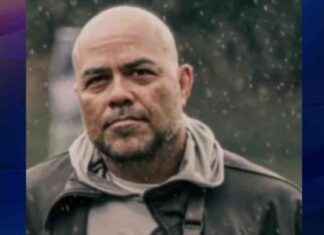COLLEVILLE-SUR-MER (France) — D-Day veterans walk on Normandy beaches and other World War II locations with mixed emotions.
Joy to see the French show gratitude and kindness towards those who arrived on June 6, 1944. They are saddened to think about their fallen comrades, and the other battle being waged in Europe: The war in Ukraine.
U.S. D-Day veteran Charles Shay thought of his fallen comrades as a bright sun rose over Omaha Beach’s wide band of sand on Monday. He told The Associated Press, “I have never forgotten their names and I know that they are still with me.”
The 98-year-old Penobscot Native American from Indian Island, Maine, took part in a sage-burning ceremony near the beach in Saint-Laurent-sur-Mer.
Shay, now living in Normandy was 19 years old when he arrived on Omaha Beach, June 6, 1944.
Shay gave the task of remembrance to Julia Kelly, a veteran of the Gulf War, this year. Kelly performed the sage ritual. She said, “Never forget, Never forget.” “War is not good in this or any other time.”
Shay’s message for young generations is “to be always vigilant.”
He said, “Ofcourse I have to tell them that they should protect the freedom they have now.”
Due to Covid-19 lockdown restrictions, D-Day ceremonies have been reduced to a minimum for the past two years.
Crowds of foreign and French visitors, including veterans in their 90s, are returning to Normandy this year to pay respect to the 160,000 soldiers from the U.S., Canada, and Britain who arrived to liberate the country.
A ceremony was held later Monday at the American Cemetery overlooking Omaha Beach, Colleville-sur-Mer.
Ray Wallace (97), a former paratrooper in the 82nd Airborne Division, was one of the many veterans who were expected to attend.
His plane was struck and set on fire by a bomber, forcing him to jump sooner than expected. He landed 20-miles away from Sainte-Mere-Eglise in France, which was the first French village liberated from Nazi occupation.
“We were all a bit scared at that point. The guy then dropped us off and we were far away from the rest of our group. It was frightening,” Wallace said to The Associated Press.
He was captured by the Germans less than a month later. After 10 months, he was finally released and returned to the U.S.
Wallace believes he was fortunate.
“I still have the good friends I lost there. It’s emotional, he admitted with sadness in his voice. “I guess you could say that I was proud of what I did, but not as much as I should have.”
When asked what was the secret to his longevity, he replied: “Calvados!” He joked about Normandy’s local alcohol, Calvados!
D-Day was the day that Allied troops landed at the beaches code-named Omaha (Utah), Juno, Sword and Gold) and were carried by 7,000 boats. In that one day, 4,414 Allied soldiers died, 2501 of which were Americans. More than 5,000 soldiers were also wounded.
Several thousand were wounded or killed on the German side.
Wallace, who was in a wheelchair, opened Saturday’s parade in Sainte-Mere-Eglise of military vehicles to a great applause by thousands of people in a joyous atmosphere. He smiled and waved to the crowd, expressing his delight at the accomplishments of World War II heroes.
Many history enthusiasts, dressed in military and civilian clothing from that period, came together to recreate the events.
On Monday, U.S. Air Force planes will fly over the American Cemetery in Colleville-surMer during the commemoration ceremony. They will be joined by Army Gen. Mark Milley (chairman of the Joint Chiefs of Staff). This place contains the gravesites for 9,386 soldiers who died during D-Day and the subsequent operations.
Dale Thompson, 82 years old, visited the site for the first time over the weekend.
Thompson, who traveled from Florida to join his wife, served with the 101st Airborne Division in the U.S. military’s early 1960s. He was not in combat while he was at home.
Thompson was walking among the thousands of marble headstones and wondered what he would do if he arrived at D-Day.








